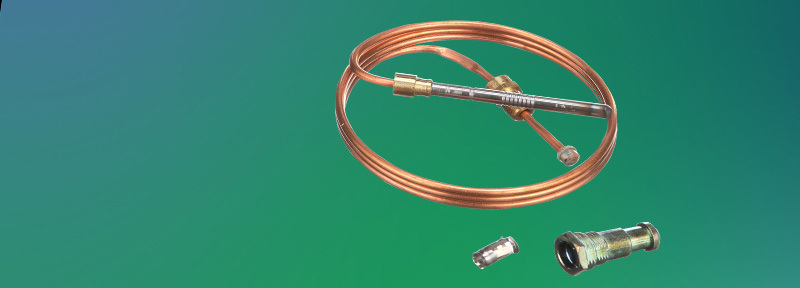
Thermocouples are critical components that ensure safe operation of gas-fired appliances inside the home, such as furnaces and hot water heaters. Many older gas-fired appliances use pilot lights, which ignite burners when there is a need for warm air or hot water. If the thermocouple fails to sense the presence of the pilot light, a thermocouple will not allow the gas valve to open preventing any kind of dangerous buildup of gas.
What is a Thermocouple & How Does it Work?
A thermocouple is two dissimilar metals joined together on one end. This junction of metals produces a very small voltage that corresponds to the sensed temperature.
The metal thermocouple is in the appliance’s pilot light flame and is always hot. If the pilot light goes out – the thermocouple will stop, producing electricity and the gas valve will never open – no heat or hot water.
Types of Thermocouples
There are several different types of thermocouples based on the many different applications they can service. Two main thermocouple groups can be distinguished through the metal materials used. One group uses base metals such as iron, nickel, or copper, and the other group uses noble metals such as rhodium, platinum, or tungsten – these are typically used for monitoring higher temperatures.
To differentiate between the many different thermocouple types, an alphabet naming convention is used, labeling thermocouples as “type B”, “type E”, “type J”, and so on. Ask your technician which type of thermocouple is best for your needs.
Other Thoughts and Tips
Gas-fired appliances can produce harmful gases and must be vented to the outside of the home. Some vents are metal, and some are special plastic pipes. On the outside of the home, there may be a special piece at the very end of the vent depending on the vent material used. Time and nature can corrode, damage, or even break off these “vent terminals”. Periodically check, especially after a bad storm that this piece is still there and intact, if you’re not sure – always call a professional.
In high wind conditions, pilot lights on the inside of homes can be extinguished by these high winds on the outside of homes. If this is happening, in some instances a baffle around the vent pipe to lessen this wind from affecting the vent pipe on the outside of the home may lessen the chance that high winds can extinguish the pilot light.
Maintenance
Thermocouples usually do not last as long as the furnaces they are installed in, so be sure to ask a professional when you should expect to replace yours. There are devices that can measure the electricity produced by a heated thermocouple. Keeping your gas-fired appliances with functioning thermocouples is one way to ensure that you always have warm air and hot water.
Don’t shut off the gas supply to gas-fired appliances with thermocouples as this can result in corrosion build-up on the thermocouple which can reduce the electricity that a thermocouple produces thereby resulting in poor or even no operation of the gas-fired appliance.
As far as regular maintenance, make sure to clean your air filter and have regularly scheduled tune-ups by a licensed professional to ensure your thermocouple and gas-fired appliances are operating properly. A filthy thermocouple can cause inaccurate readings, resulting in poor operation.
Read Next: Advantages of Modulation: Modulating vs. Single and Two-Stage Furnaces
Expand your knowledge: Optimizing Your Homes Comfort with More HVAC Articles


